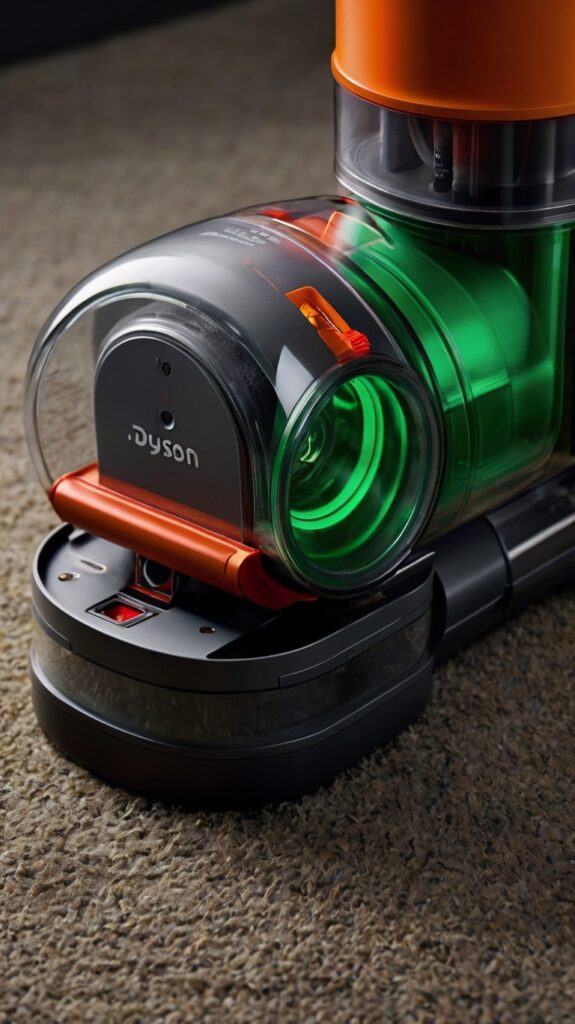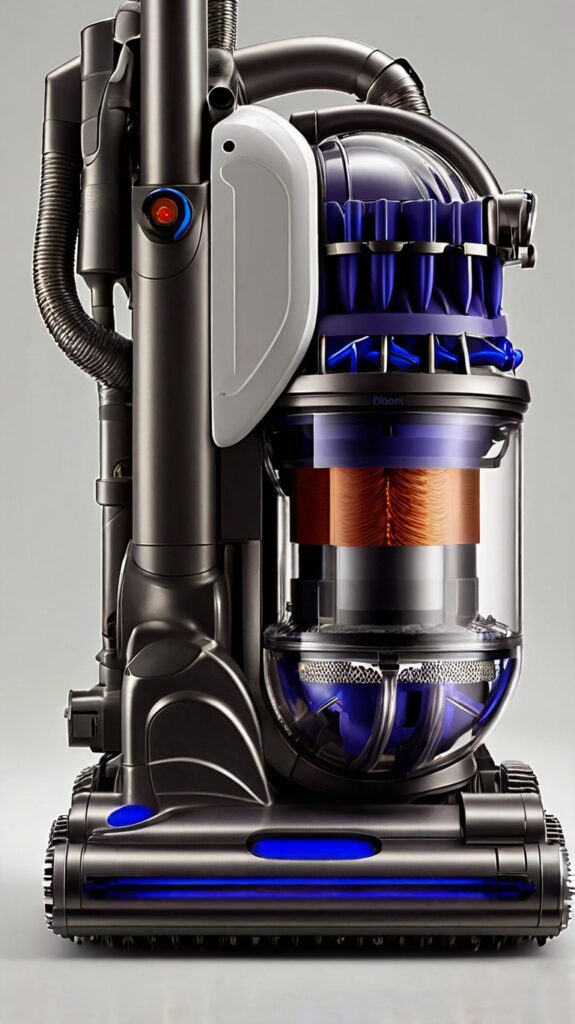Hook the reader:
Tired of your Dyson losing suction halfway through cleaning? A dying battery can be frustrating!
Present the problem:
Dyson vacuums are known for their powerful suction and design, but a common issue is a dying battery. Factors like heavy use, aging, and rare manufacturing defects can all lead to reduced battery life. This can disrupt your cleaning routine and leave you with a vacuum that doesn’t hold a charge, causing frustration when you depend on it for a clean home.
Promise the solution:
Don’t worry, though—this post will guide you through the best solutions to revive your Dyson vacuum. Whether it’s replacing the battery, performing a few maintenance tricks, or even considering the purchase of a new vacuum, we’ve got you covered. We’ll explore each option in detail, ensuring you can make an informed decision and get your Dyson back to its optimal performance. So, let’s dive in and tackle that dying battery once and for all!

1. Identifying the Problem
Symptoms:
Recognizing the signs of a failing Dyson battery is the first step towards addressing the issue. Here are some common symptoms to watch out for:
- Loss of Suction: One of the most noticeable signs is a significant drop in suction power. If your Dyson no longer picks up debris as efficiently as it used to, the battery might be struggling to supply adequate power.
- Reduced Runtime: Another clear indicator is a reduced operating time. If your vacuum doesn’t run as long as it used to on a full charge, it could be a sign that the battery is nearing the end of its lifespan.
- Won’t Charge: A more obvious symptom is when the vacuum simply won’t charge. You might plug it in, but the battery level doesn’t increase, or the charging indicator light doesn’t turn on.
- Intermittent Power: Sometimes, a failing battery can cause the vacuum to work intermittently, shutting off and on without any clear reason. This can be particularly frustrating when trying to clean larger areas.
- Overheating: If your Dyson becomes unusually hot during use, it could be a sign that the battery is overworking or nearing failure.
Causes:
Understanding the root causes of battery failure can help in preventing future issues and deciding on the best course of action. Here are some of the most common reasons:
- Heavy Use: Frequent and intensive use can drain a battery’s capacity over time. If you use your Dyson daily or for extended periods, the battery will naturally degrade faster.
- Age: As with all rechargeable batteries, those in Dyson vacuums have a limited lifespan. Over time, even with moderate use, the battery will lose its ability to hold a charge.
- Manufacturing Defects: Occasionally, batteries may have defects that weren’t apparent during the initial quality checks. These defects can lead to premature battery failure.
- Improper Charging: Regularly overcharging or undercharging the battery can significantly shorten its lifespan. It’s essential to follow the manufacturer’s instructions regarding charging practices.
- Environmental Factors: Extreme temperatures, both hot and cold, can negatively impact battery performance. Storing or using your Dyson in such conditions can lead to faster battery degradation.
- Lack of Maintenance: Failing to maintain your vacuum properly, such as not cleaning the filters or removing blockages, can put additional strain on the battery, causing it to wear out more quickly.
By identifying these symptoms and understanding their causes, you’ll be better equipped to address your Dyson’s battery issues effectively. In the next section, we’ll explore practical solutions to these problems, helping you restore your vacuum to its full functionality.

Solutions
Battery Replacement
Pros: Replacing the battery of your Dyson vacuum can be a straightforward and cost-effective solution. It’s a relatively quick fix that can restore your vacuum’s performance to like-new condition. Since most Dyson models have user-friendly designs, swapping out the battery doesn’t require advanced technical skills.
Cons: However, this may not be a long-term solution if your vacuum has recurring issues. If the underlying problem is more significant than just the battery, you might find yourself facing the same issues again soon.
Where to Buy: It’s crucial to purchase your replacement battery from trusted retailers to ensure compatibility and quality. Recommended sources include:
- Dyson Official Website: They offer original batteries specifically designed for your model.
- Amazon: You can find both original and high-quality third-party batteries with customer reviews to guide your choice.
- Local Electronics Stores: Stores like Best Buy or Walmart often carry compatible Dyson batteries.
Tutorial: Here’s a step-by-step guide to replacing your Dyson battery:
- Turn off and Unplug: Ensure your vacuum is turned off and unplugged.
- Remove the Old Battery:
- Locate the battery release button or screws (this varies by model).
- Press the button or unscrew the battery and gently pull it out.
- Install the New Battery:
- Align the new battery with the slot and push it in until it clicks or fits snugly.
- If screws are involved, secure the new battery with the screws provided.
- Charge and Test:
- Plug in your vacuum and let the new battery charge fully before use.
- Test the vacuum to ensure it’s working correctly.
For a visual guide, refer to this YouTube tutorial specific to your Dyson model.

Professional Repair
When to Seek: If replacing the battery doesn’t resolve the issue or if your vacuum has additional problems (such as motor issues or broken components), it might be time to seek professional repair.
Pros: Professional repair services offer guaranteed work with original parts, ensuring your Dyson is fixed correctly and will perform optimally.
Cons: The main drawback is the higher cost compared to DIY solutions. However, the investment can be worthwhile for a thorough and lasting repair.
Authorized Service Centers: Locate an authorized Dyson service center through their official website.
Purchasing a New Vacuum
When to Consider: If your Dyson vacuum is quite old, or if it has multiple issues beyond the battery, purchasing a new vacuum might be the most sensible option. Newer models come with improved technology and longer battery life, making your cleaning routine more efficient.
Tips for Choosing: When selecting a new vacuum, consider the following factors:
- Battery Life: Look for models with long battery life, ideally over 60 minutes of runtime.
- Suction Power: Ensure the vacuum has strong suction to handle your cleaning needs.
- Attachments: Check for useful attachments like crevice tools, dusting brushes, and motorized heads.
- Weight and Maneuverability: A lightweight and easy-to-maneuver model can make cleaning less of a chore.
- Reviews: Read customer reviews to gauge the performance and reliability of the model.
Recommended Models:
- Dyson V11 Torque Drive: Offers powerful suction, a long-lasting battery, and intelligent cleaning modes.
- Dyson V8 Absolute: A more affordable option with excellent performance and versatility.
- Shark IZ163H Rocket Pet Pro: A strong contender with good battery life and suitable for homes with pets.
By exploring these solutions, you can effectively address the battery issues with your Dyson vacuum, ensuring it performs at its best and continues to serve your cleaning needs efficiently.
Tips to Extend Battery Life
Extending the battery life of your vacuum cleaner is essential for maintaining its performance and ensuring it lasts longer. Here are some practical tips to help you maximize the lifespan of your vacuum’s battery:
Charging: How to Charge the Battery Correctly
- Follow Manufacturer’s Instructions: Always refer to the manufacturer’s guidelines on charging your vacuum cleaner. Different models might have specific requirements.
- Avoid Overcharging: Once the battery is fully charged, unplug it from the charger. Overcharging can reduce the battery’s overall lifespan.
- Use the Correct Charger: Ensure you are using the charger that came with your vacuum cleaner. Using a different charger can damage the battery and reduce its efficiency.
- Charge Before Full Depletion: Lithium-ion batteries, commonly used in vacuums, should not be allowed to fully deplete regularly. Charge the battery when it gets down to about 20-30% to maintain its health.
- Store at Partial Charge: If you plan to store your vacuum for an extended period, charge the battery to about 50% rather than leaving it fully charged or completely empty.
- Optimal Charging Environment: Charge your vacuum in a cool, dry place. Extreme temperatures can negatively affect battery performance.
Usage: Tips to Avoid Overworking the Battery
- Use Appropriate Power Settings: Many vacuums have different power settings. Use lower power settings for light cleaning tasks to conserve battery life.
- Short, Frequent Cleaning Sessions: Instead of long cleaning sessions, opt for shorter, more frequent cleanings. This prevents the battery from overheating and overworking.
- Clean Efficiently: Plan your cleaning route to avoid unnecessary movement and reduce the time the vacuum is in use. Focus on areas that need the most attention.
- Avoid Using Boost Mode Excessively: Boost or turbo modes drain the battery quickly. Use these modes sparingly and only when necessary.
- Turn Off When Not in Use: If you need to move furniture or take a break, turn off the vacuum to save battery life.
Maintenance: Cleaning the Battery and Filters
- Regularly Clean the Filters: Dirty filters force the vacuum to work harder, draining the battery faster. Clean or replace filters according to the manufacturer’s recommendations.
- Wipe Down the Battery Contacts: Dust and debris can accumulate on the battery contacts, affecting performance. Use a dry cloth to gently wipe the contacts periodically.
- Keep the Vacuum Clean: Regularly empty the dustbin and remove any debris from the vacuum’s brush roll and other components. A clean vacuum operates more efficiently and uses less battery power.
- Inspect for Damage: Periodically check the battery and charging ports for any signs of damage or corrosion. If you notice any issues, contact the manufacturer for advice or replacement.
- Avoid Moisture Exposure: Batteries and moisture don’t mix. Keep the battery and the vacuum itself away from water and high humidity areas.
By following these tips, you can ensure that your vacuum cleaner’s battery remains in good condition, providing optimal performance and longevity. Proper charging, mindful usage, and regular maintenance are key to extending the life of your vacuum’s battery.
Summary
In this post, we’ve covered essential tips to help you extend the battery life of your vacuum cleaner, ensuring it operates at peak performance for as long as possible. Here’s a quick recap:
- Charging Tips: We discussed the importance of following the manufacturer’s instructions, avoiding overcharging, using the correct charger, and charging before the battery fully depletes. We also emphasized storing the battery at partial charge and charging in a cool, dry environment.
- Usage Tips: To avoid overworking the battery, we recommended using appropriate power settings, opting for short and frequent cleaning sessions, cleaning efficiently, sparingly using boost mode, and turning off the vacuum when not in use.
- Maintenance Tips: Regular maintenance is crucial for battery longevity. This includes cleaning the filters regularly, wiping down battery contacts, keeping the vacuum clean, inspecting for damage, and avoiding moisture exposure.
By incorporating these tips into your routine, you can significantly enhance the lifespan and efficiency of your vacuum cleaner’s battery.
We’d love to hear from you! Do you have any questions or experiences you’d like to share about maintaining your vacuum cleaner’s battery? Leave a comment below with your tips or queries, and let’s start a conversation to help each other out.
